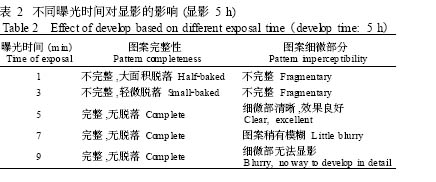3. 3 coating and screen washing method
Photosensitive adhesive coating is very tricky, multiple coating method [7] is time-consuming and laborious and prone to problems, such as uneven drying leads to delamination. In this study, it was improved and it was painted once and it was simple and easy. When the screen was washed to remove oil and dust, the method [6] using 10% NaOH aqueous solution to wash, there is a certain risk of operation, and damage to the frame. In this study, the method of using washing spirit water washing is safe and effective.
3.4 Effect of Exposure Time on Development
The key to drying the net is time. If the time is too short, the photosensitive adhesive is underexposure, and it is easy to fall off during development. If the time is too long, the edge of the pattern may be blurred, and the fine portion may not even be developed, resulting in failure of the plate making. Table 2 shows the effect of different exposure times on development.

3. 5 development time
Development is an important step in visualizing the slick image. Conventional screen printing adopts the water developing method. This method has fast developing speed and high efficiency. However, due to the large momentum of the water, the fine parts of the pattern on the screen will be damaged.
It has been found that the method of static development by tapping the screen with tap water is more suitable for the complete development of the fine parts. Moreover, the length of the development time can also control the thickness of the photosensitive adhesive attached to the web, thereby affecting the thickness of the printed electrode film. The effect of different development times on the thickness of the photosensitive film was compared. The results are shown in Table 3. In the experiment, a development time of about 5 h was selected. At this time, the obtained film thickness was relatively moderate, and the unexposed portion was completely exposed, which was in line with the follow-up work requirements.

3. 6 hardening time
The hardening film is a process of re-exposing the developed film. After a hard film, the non-shedding film can be better adhered to the screen to prevent the film from falling off during the subsequent printing. Harden film time can be fully exposed by the photosensitive adhesive on the outer surface of the screen. The time cannot be too short. Referring to the first exposure time, to ensure full exposure, the experiment takes 3 times of the initial exposure time as the hardening time. Indicates that the requirements can be met. It will do no matter if the hardening time is longer.
3. 7 Distance between the web and the substrate and the number of squeegee
When printing, pay attention to the distance between the web and the substrate, generally 3 to 4 mm. The gap is too small, the substrate is easy to adhere to the omentum, resulting in a blurred pattern; the gap is too large, and the paste to be printed cannot be completely printed on the substrate, resulting in the incomplete pattern. The number of squeegees for a squeegee is usually 1 time, up to 2 times. Excessive number of times will blur the pattern and the subtle parts will be connected, causing the printing to fail. After each step is printed, it must be placed in an oven and dried with heat to completely evaporate the solvent in the slurry and fix the slurry and the substrate completely, so as to prevent the subsequent printing process and the excessive diffusion of overlapping portions of the respective slurry. In order to ensure the excellent electrical conductivity of the electrode.
3. 8 Electrochemical examination
The electrode reversibility was judged as shown in Figure 2. Cyclic voltammogram scanning between 0. 2 and 0. 5 V 4 times, there is an anodic peak (A1, A2) at the time of the positive scan; there is a cathode peak (C1 and C2) at the time of reverse scan, ipa / ipc < 1, ΔEp = 91 mV, it can be considered that the redox reaction of potassium ferricyanide on the screen printed microelectrode under the experimental conditions is an irreversible process. The redox peaks obtained from the two scans basically coincide with each other, and it can be seen that the microelectrode obtained by screen printing has good stability. In addition, the higher peak current indicates that this electrode has higher sensitivity and excellent electrochemical performance.

Author/Zhang Jun 1, 2 Guo Wei 3 Yuan Yubin 3 1, 2
1 (Institute of Applied Chemistry, Graduate University of Chinese Academy of Sciences, Beijing 100049, China)
2 (Institute of Applied Chemistry, University of Science and Technology of China, Beijing 100049, China)
3 (Center for Ecological Environment Research, Chinese Academy of Sciences, Beijing 100085)
Chemicals,Chemicals In Cigarettes,Chemicals In Weed,Chemicals In Tobacco
Bady/Adult Diaper Raw Materials Co., Ltd. , http://www.nbbadydiaper.com
